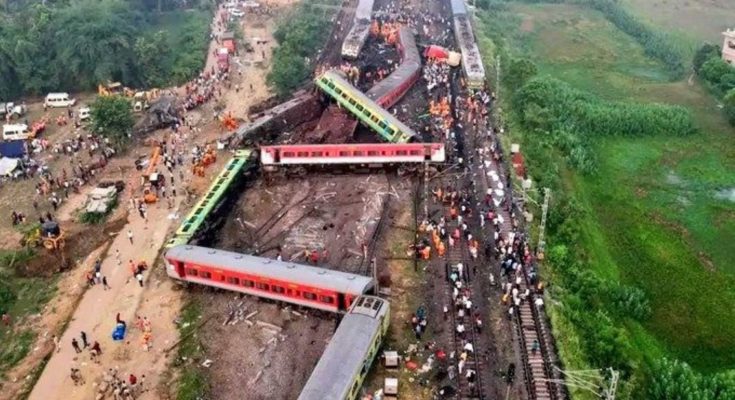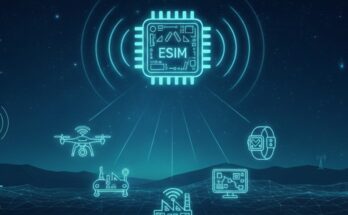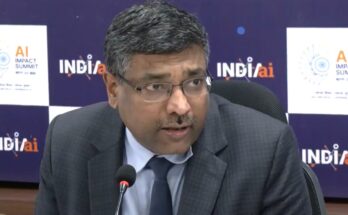By Jayajit Dash
Triple Train Disaster: In a world teeming with modern marvels, few events are as harrowing and heartbreaking as train accidents. These catastrophic incidents claim countless lives, inflict grave injuries, and leave behind a trail of destruction that cuts to the core of our existence. The World Health Organization (WHO) reveals a chilling truth: each year, over 2,000 souls succumb to the horrors of train accidents.
The echoes of grief and loss still reverberate as we talk about the cataclysmic triple train collision that occurred in Odisha’s Balasore on that fateful day, the 2nd of June 2023. The haunting tragedy, which snuffed out at least 288 lives (till this piece ran) and wounded hundreds more, shook the very foundations of our souls. Initial reports indicate that the collision was triggered by a grievous signaling error, leading one train to a path of doom where it collided with a motionless goods train, derailing another coming from the opposite direction. Later, the authorities ascribed the disaster to electronic interlocking.
In the aftermath of such horrors, we find ourselves grappling with disquieting questions about the safety and reliability of our railway systems, particularly in developing nations like India, where vast, labyrinthine networks often bear the burden of technological obsolescence. In the face of this crisis, we must inquire: How can we prevent the occurrence of such calamities in the future? What role can emerging technologies play in fortifying the fortress of train safety? In this piece, we embark on a journey of exploration, guided by the flickering beacon of hope emanating from disruptive technologies such as artificial intelligence (AI), analytics, sensors, blockchain, and the transformative power of 5G.
AI and Analytics: Illuminating the Path to Safety
Within the realm of AI and analytics lies a profound capacity to process immense volumes of data, birthing insights, predictions, and recommendations through the alchemy of algorithms and models. These twin titans stand ready to revolutionize multiple facets of train safety:
Signalling and communication: With their potent prowess, AI and analytics hold the key to refining the accuracy and reliability of our signalling and communication systems—a lifeline crucial for orchestrating the ballet of trains and averting fatal collisions. Picture a world where AI tirelessly detects and rectifies errors and anomalies, rescuing signals, tracks, and trains from the clutches of catastrophe. Witness the transformation as AI optimizes traffic flow, alleviating congestion through real-time adjustments to train speed, frequency, and routing. Analytics, in turn, lends its keen eye to monitor and analyze the performance and efficiency of these systems, unveiling potential risks, imminent failures, and the path to rectification.
Maintenance and inspection: Within the hallowed halls of maintenance and inspection, AI and analytics paint a vivid portrait of progress and security. Imagine an automated inspection process, invigorated by the brilliance of computer vision, natural language processing, and machine learning, detecting defects, cracks, and wear-and-tear in trains and tracks with unerring accuracy. AI, acting as a beacon of prioritization, ensures that the most critical maintenance tasks take precedence, guided by the urgency, severity, and impact of each challenge. Analytics, the vigilant sentinel, observes and evaluates the condition and performance of trains and tracks, chronicling patterns and trends that portend deterioration, allowing for optimal maintenance schedules and timely interventions.
Accident prevention and response: In the realm of accident prevention and response, AI and analytics emerge as beacons of salvation, their guidance instrumental in safeguarding lives. Picture a world where AI, steeped in the annals of historical data, current conditions, and future scenarios, unfurls its prescience, predicting potential accidents before they materialize. See the flicker of hope as AI activates safety measures—braking systems, emergency lights, and alarms—when a collision or derailment looms on the horizon. As the dust settles, analytics, the impartial observer, pieces together the fragments of chaos, assessing the severity and consequences of accidents through the analysis of sensor data, captured images, and eyewitness accounts. Armed with this knowledge, analytics orchestrates rescue efforts with unparalleled efficiency, relaying critical information on casualties, locations, and available resources.
Sensors: Guardians of the Tracks
In the pantheon of train safety, sensors stand as the silent sentinels, ever watchful, monitoring the pulse of the railway world. These devices, endowed with the ability to measure temperature, pressure, vibration, sound, and light, weave a web of protection by gathering data on crucial aspects of train safety:
Train status: Sensors, attuned to the heartbeat of trains, stand as vigilant guardians. They monitor the speed, acceleration, deceleration, position, direction, and weight of these steel behemoths. With an unwavering gaze, they detect any irregularities—be it overheating, leakage, or fire—that threaten the delicate balance of safety.
Track condition: The watchful eyes of sensors peer into the soul of the tracks, capturing the essence of their condition. They gauge the curvature, slope, alignment, and stability of these sinuous paths. Vigilant, they spot hazards and obstacles—cracks, debris, or the unwelcome presence of animals or any other obstruction—that lie in wait to sabotage the smooth passage of trains.
Environment: Sensors, ever attuned to the pulse of the world that surrounds us, imbibe the very essence of our environment. They measure the weather, temperature, humidity, and visibility, discerning the nuances that may imperil the safe passage of trains. With their discerning senses, they stand as a bulwark against external threats and disturbances—landslides, floods, or earthquakes—that lurk in the shadows.
To serve their purpose, these beacons of insight transmit the data they gather, harnessing wireless communication technologies like Wi-Fi, Bluetooth, and the transformative power of 5G. A symphony of connection forms, as this data reaches a central system or platform, where AI and analytics wait to weave their magic, transforming raw information into invaluable insights, predictions, and recommendations, safeguarding the lives that depend on the railways.
Blockchain: A Fortress of Trust
At the heart of our quest for train safety, blockchain emerges as a bastion of trust, bestowing upon us the gift of security and transparency. This technology, with its distributed and decentralized architecture, offers an immutable and verifiable record of transactions and events. Its vast potential, when applied to train safety, unfolds across various realms:
Ticketing and identity: Within the realm of ticketing and identity verification lies a world transformed by the impenetrable security and seamless efficiency of blockchain. Imagine a future where digital tickets and identities, encrypted, unique, and traceable, come to life. In this realm, blockchain reigns supreme, verifying the authenticity and validity of tickets and identities through biometric and cryptographic methods, forever shielding us from the scourge of fraud, theft, and misuse.
Supply chain and logistics: The unyielding gaze of blockchain illuminates the supply chain and logistics systems, fostering a realm of transparency and accountability. Behold a world where blockchain tracks the origin, movement, and destination of trains, tracks, and equipment. It ensures the integrity and certification of these vital components through smart contracts and digital signatures, affording us a realm free from ambiguity and doubt.
Insurance and compensation: Within the realm of insurance and compensation, blockchain weaves a tapestry of fairness and efficiency. Picture a future where smart contracts, forged on the anvil of blockchain, dictate the terms and conditions of insurance or compensation policies. In this realm, blockchain automates the claims and payments process, drawing on the insights gleaned from sensors, cameras, and witnesses. It grants us a realm where financial protection and support flow swiftly and unimpeded to the victims and stakeholders ensnared in the aftermath of an accident.
5G: The Nexus of Possibilities
In the realm of train safety, 5G reigns supreme, a nexus of possibilities that brings with it high-speed, low-latency, and reliable wireless communication. With this transformative technology at our fingertips, we step into a world brimming with potential, where the threads of safety intertwine:
Remote control and operation: Behold the marvel of remote control and operation, where 5G serves as the conduit between trains and the central control center. From this vantage point, every aspect of the train’s movement and functions can be monitored, controlled, or overridden, eliminating the specter of human error, fatigue, and distraction.
Autonomous driving: In the realm of autonomous driving, 5G emerges as the catalyst, propelling trains into a future of efficiency, convenience, and comfort. Through its seamless connection to a network of sensors, cameras, and satellites, trains receive real-time data on traffic, weather, and terrain. This interconnected realm fosters communication, coordination, and cooperation between trains, creating a world where safety and harmony reign supreme.
Track-ingit better
Train safety, an endeavor that resonates with millions across the globe, stands as a testament to our unwavering commitment to preserving life. In this quest, emerging technologies—AI, analytics, sensors, blockchain, and 5G—emerge as beacons of hope, illuminating the path forward. Yet, they also present challenges, a crucible of cost, complexity, compatibility, regulation, and ethics that must be navigated with utmost care. A holistic and collaborative approach, one that unites governments, railways, industries, researchers, and users, is the key to unlocking the true potential of these transformative technologies. By embracing the promise of these emerging technologies, we embark on a journey where we can prevent ormitigate the impact of devastating accidents.




